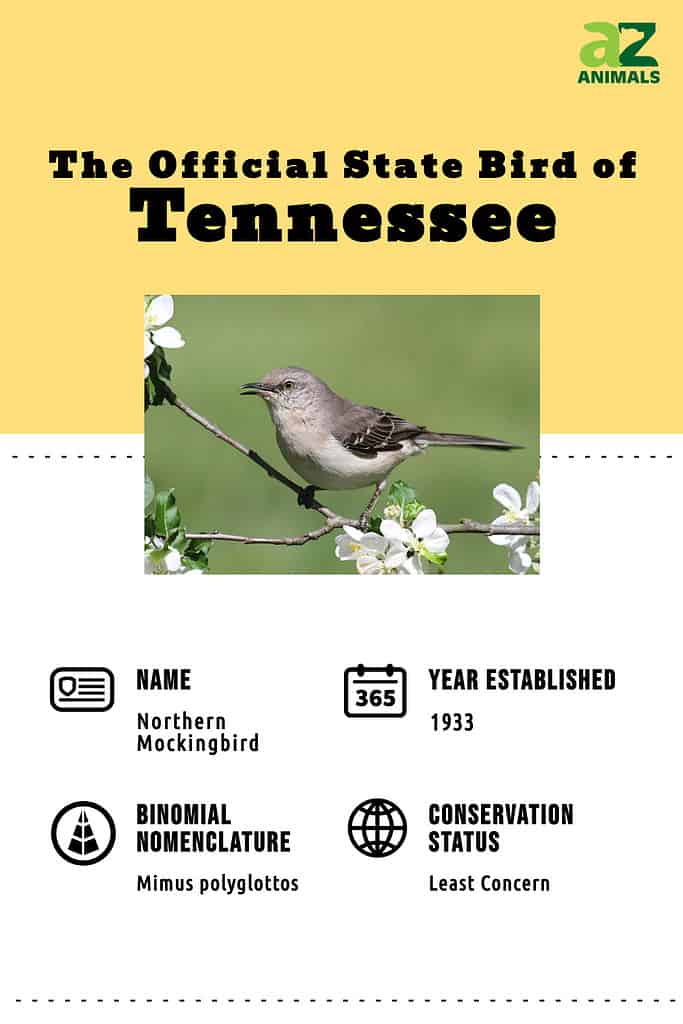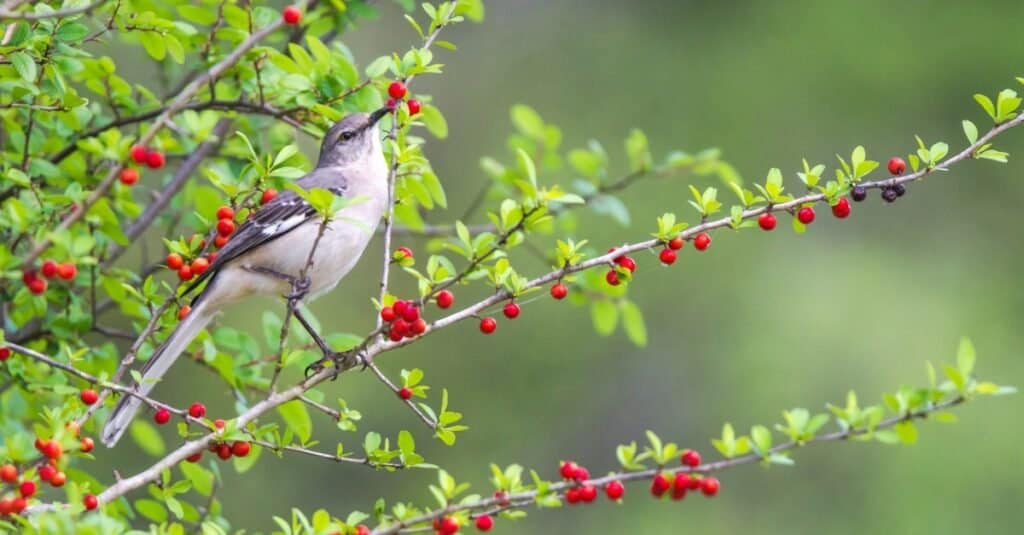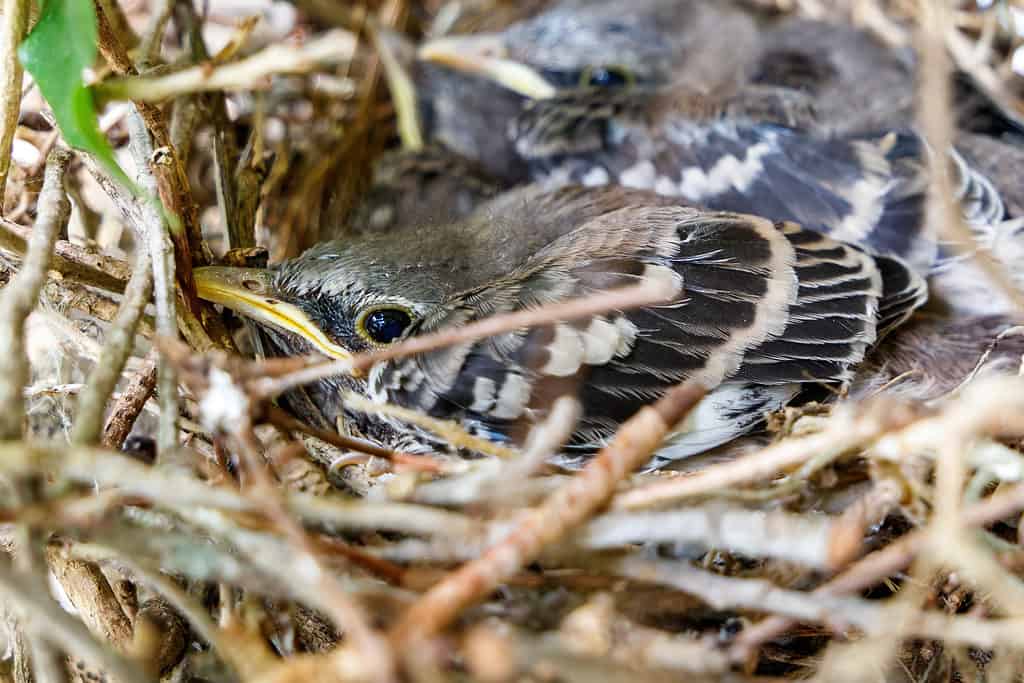The official Tennessee State Bird is the Northern Mockingbird (Mimus polyglottos). A total of five states have chosen the Northern Mockingbird as their official State Bird. Voters in Tennessee chose the species in a special election organized by the Tennessee Ornithological Society on April 11, 1933. The legislature confirmed the Northern Mockingbird as the State Bird of Tennessee via Senate Joint Resolution 51 eight days later, on April 19, 1933.

The following states also selected the Northern Mockingbird as their State Bird: Texas and Florida, both in 1927, Arkansas in 1929, and Mississippi in 1944. Tennessee was the fourth state to adopt the species as a state emblem. The Northern Mockingbird is the third most popular state bird, behind the Northern Cardinal, which represents seven states, and the Western Meadowlark, which represents six.
Sports fans may be interested to note that exactly half the teams from the NCAA Southeastern Conference, including the University of Tennessee and Vanderbilt University, come from states that have chosen the Northern Mockingbird as their official State Bird. This ratio will remain the same even following the 2024 expansion of the SEC.
Where Does the State Bird of Tennessee Live?

Northern Mockingbirds have an extensive range covering much of North America.
©Chris Klonowski/Shutterstock.com
Northern Mockingbirds range over the entire state of Tennessee. In fact, their range extends over all of the continental United States, southern Canada, and much of Mexico and the Caribbean. Of the 14 known species of mockingbirds, the Northern Mockingbird has the northernmost range. These birds are mostly permanent residents of the areas where they live. The population in Tennessee does not migrate. They stick closely to the same place all year round.
Northern Mockingbirds live in a variety of habitats. These birds can often be found in forest edges, but they generally do not live deep within dense forests. They frequently live along fencerows, in grasslands with shrubs and thickets, on farms near open pastures with nearby wooded areas, and in areas like parks or neighborhoods. They are especially drawn to areas with abundant berry-producing shrubs, bushes, or trees.
Northern Mockingbirds prefer sparse trees over crowded forests, and open areas with access to shrubs, hedges, or other cover. They seem equally comfortable in rural and remote areas as they are in suburban or even urban settings. This species has adapted well to life alongside human populations. People often spot them sitting on high perches, on tree branches, or on artificial structures, as they hunt for food. Many bird enthusiasts and backyard bird watchers count the species among their favorites, due to their rich and varied repertoire of songs.
What Does the State Bird of Tennessee Eat?

Northern Mockingbirds are especially drawn to berry-producing trees and shrubs.
©iStock.com/Kanokwalee Pusitanun
Northern Mockingbirds are omnivores. They eat many types of invertebrates, especially insects, including beetles, ants, grasshoppers, wasps, and others. They also eat spiders, earthworms, crustaceans, snails, and even small lizards. During the fall and winter, especially, they eat more seeds, berries, and other fruits, both wild and cultivated.
At feeders, Northern Mockingbirds prefer suet, fruits, and mealworms over seeds. They do not commonly eat seeds from feeders, but if a feeder is too close to a mockingbird’s territory, it may aggressively chase other birds away.
Where Do Northern Mockingbirds Nest?
As the State Bird of Tennessee, the Northern Mockingbird can find plenty of suitable nest sites all around the Volunteer State. The breeding season in Tennessee begins in late March and stretches into August. Northern Mockingbirds form generally monogamous pairs, which may produce as many as four broods in one season. Each clutch consists of between three to five eggs.
Both the male and female Northern Mockingbird work together to build their cup-shaped nest. They place the nest in a tree or shrub, usually no more than about 10 feet above the ground, although sometimes they build far higher. They fashion the nest with twigs and line it with softer materials such as grasses, rootlets, and dead leaves.
Northern Mockingbird Eggs
Northern Mockingbirds produce up to four clutches per year. Each clutch averages three to five eggs. The eggs vary in color, from blueish to greenish, with dark, reddish-brown speckles. Females incubate the eggs alone for about 12 to 13 days, then both parents care for the nestlings until they leave the nest in another 12 days.

Baby Northern Mockingbirds (Mimus polyglottos) fledge from the nest after 12 days.
©Microfile.org/Shutterstock.com
What Do Northern Mockingbirds Look Like?
The State Bird of Tennessee is easy to recognize. Northern Mockingbirds are among the larger songbirds of North America and are frequently occupied with singing. Males have a repertoire of up to 200 different songs, and they can mimic everything from other birds to machinery. The Northern Mockingbird has gray plumage above with white below. They reach lengths of about 10 inches, and they have a sleek appearance, owing largely to their long, pointed bills and their long tails. They have a wingspan of up to 14 inches, with darker gray wings featuring two white wing bars. These bars are prominent during flight, and the Northern Mockingbird often flashes their wings in defensive displays.
Are Northern Mockingbirds Rare?
The Northern Mockingbird has a stable population throughout its range, from far southern Canada through the entire continental United States, much of Mexico, and the Caribbean. The range of this species is vast. It is not highly fragmented and has extended significantly to the north in recent decades. The Northern Mockingbird has adapted well to many different types of habitats, including urban and suburban areas, and is a permanent resident throughout its distribution. The State Bird of Tennessee is neither rare nor threatened within its home range.
The photo featured at the top of this post is © Steve Byland/Shutterstock.com
Thank you for reading! Have some feedback for us? Contact the AZ Animals editorial team.







